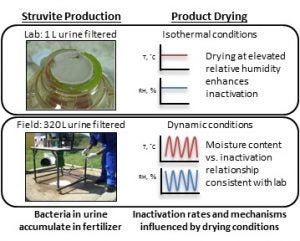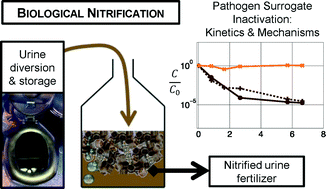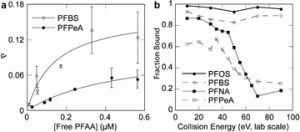
Overview of Topic Areas
Environmental Monitoring of Viruses | Resource-Oriented Sanitation | Water for Ecosystems | Contaminant Bioaccumulation and Biotransformation
A list of publications can be viewed at: Google Scholar | Research Gate
Current and Recent Projects
Environmental Monitoring and Inactivation of Viruses
- Evaluating inactivation of viruses by enzymes in wastewater
- Advancing health equity using wastewater-based epidemiology in the Central Valley (Healthy Yolo Together and Healthy Central Valley Together)
- Wastewater-based epidemiology: aligning sub-sewershed monitoring and COVID-19 cases in Davis (Heathy Davis Together)
- Developing flow cytometry tools for monitoring viruses in recycled water (projects funded by the US Bureau of Reclamation and US Environmental Protection Agency)
- Air filter and surface monitoring of to support safe reopening of schools (Healthy Davis Together)
Resource-oriented Sanitation:
- Making fertilizers from waste as part of a container-based sanitation system in Guatemala: Enriching biochar produced from fecal waste with nutrients from alkaline-stabilized urine from urine-diverting dry toilets
- Protecting human health in resource-oriented fecal sludge management using Viscous Heater pre-treatment for black soldier fly larvae growth
- Quantitative microbial risk assessment of the sanitation value chain: The case of urine collection and struvite fertilizer production in Durban, South Africa
- Microbial Health Risks for sanitation service workers: a comparison of fecal sludge emptying techniques
Water for Ecosystems
- Assessment of woodchip bioreactors for pesticide removal in agricultural tile drainage
Contaminant Bioaccumulation and Biotransformation:
- Evaluating associations of poly- and per-fluoroalkyl substances in aqueous fire-fighting foam with model proteins
- Evaluation of pesticide bioaccumulation in black soldier fly larvae
Environmental monitoring and inactivation of viruses
Research underway in my group seeks to develop flow cytometry as a tool for near real-time monitoring of viruses in recycled water. In an open-call “Pathogen Monitoring Challenge” from the US Bureau of Reclamation, our team won the competition’s top prize. The Bureau partnered with a global water technology provider, the Water Research Foundation, and the US Environmental Protection Agency in seeking ideas “for the development of rapid, accurate and preferably online/onsite monitoring techniques for various pathogens at advanced water treatment facilities.” Our work on flow cytometry builds on collaborative reviews of molecular techniques for pathogen monitoring.To broaden applications of flow cytometry for detection of diverse viral targets in the future, my group is now working to characterize the influence of virus properties (e.g., lipoprotein envelope, protein capsid structure, and genome type) on virus detection.
The field of wastewater-based epidemiology (WBE) has greatly expanded in response to COVID-19. My contributions to WBE began in 2012 through an evaluation of enteric pathogens and pharmaceuticals in decentralized, non-sewered sanitation systems in Durban, South Africa . The knowledge I gained from this work eventually led to my leadership role in Healthy Davis Together (HDT), a broad partnership between UC Davis and the City of Davis. As part of HDT, I direct campus- and city-wide environmental monitoring of SARS-CoV-2. We developed new strategies to monitor COVID-19 and support data-driven decision-making using wastewater infrastructure at city-, neighborhood-, and building-scales.
Our WBE research overall also focuses on “sub-sewershed” monitoring (at a neighborhood and building scales). Check out this video about monitoring SARS-CoV-2 in Wastewater at UC Davis and the City of Davis: https://video.ucdavis.edu/media/1_kecjwnss . We designed sampling in Davis to cover across the city as well as to monitor areas with elevated risks of transmission, social vulnerability, and co-morbidities. We integrated resultant data with geo-targeted community messaging systems to provide rapid and targeted information on COVID-19 trends from wastewater to the public. I collaborate with statisticians, epidemiologists, and health bioinformaticians at UC Davis on Bayesian modeling approaches that will facilitate comparisons with known clinical COVID-19 cases at each scale of monitoring (publication in preparation) and quantification of uncertainty in decision-making from wastewater data. This research is broadly applicable to environmental monitoring of pathogens using quantitative PCR, where challenges in the interpretation of censored data are widespread and problematic. Moving forward, we are working to identify emerging pathogens in wastewater and build enduring capacity for wastewater monitoring in low-income regions of California by focusing on sampling and analytical challenges in small-scale systems.
Enhancing Health and Hygiene in Resource Recovery
for more Sustainable Sanitation


An important theme of my recent work has been the protection of human health in the development of innovative resource recovery operations. This work has evaluated microbial inactivation processes during the extraction of nutrients from human urine to produce marketable fertilizers. We are also evaluating the microbial safety of products derived from fecal sludge — specifically focusing on the inactivation of microorganisms during heat treatment of sludge and the growth of black soldier fly larvae.
Urine is often falsely considered sterile, or nearly-so. Our work showed consistent cross-contamination of urine with pathogen-containing feces in a urine-diverting dry toilet system located in Durban, South Africa. The results emphasized the need to consider the health risks in handling urine and processing the material into valuable fertilizers.

Subsequently, we evaluated the inactivation of pathogen surrogates during the production of (solid) struvite fertilizers or (liquid) nitrified fertilizers from urine. We recommended simple design strategies to improve inactivation of microbial contaminants in urine to make a safer struvite endproduct. We found limited inactivation during nitrification requires further treatment following this process.
I have also worked to quantify health risks throughout the entire sanitation value chain, from urine collection through fertilizer production. The objective of this work is to identify critical control points to protect individuals involved in resource recovery and to improve endproduct safety. The research applies videography as a tool to evaluate human-environment interactions for modeling disease transmission, as described in the video publication below:
Water Reuse for Ecosystem Enhancement

This work explores opportunities to directly benefit ecosystems through the application of recycled water for environmental restoration projects. The overarching goals of the work are to identify design strategies that improve water quality and generate valuable ecosystem services. “Stream Renewal” projects that apply recycled water for ecosystem enhancement can help revitalize degraded urban streams and provide ecosystem benefit. While the biological responses to recycled water applications in natural systems, water provided for instream flows and public access to waterways can provide important economic value to communities.
Perfluoroalkyl Acids, Proteins, Bioaccumulation

This work has sought to evaluate exposure to and bioaccumulation mechanisms of per- and polyfluoroalkyl substances (PFASs) by understanding PFAS-protein interactions. Unlike many persistent organic pollutants, PFASs do not typically partition into fatty tissues. It was hypothesized that binding to proteins may instead be an important mechanism for observed bioaccumulation of these chemicals.
Perfluorooctanoate (PFOA) is the most notorious of the PFAS class of persistent chemicals of concern and was used in many commercial and industrial applications since the 1950s. Human exposure to PFOA is linked to cancer, elevated cholesterol, and immune suppression, among others. We found that PFOA binds strongly to human serum albumin (Bischel et al., 2010). Binding of such long-chain PFASs to proteins has now been included in bioaccumulation models for these compounds (Ng and Hungerbühler, 2014, 2013). As a result of health concerns, PFOA and other long-chain perfluorinated compounds were phased out of production in the United States in the early 2000s. However, production of so-called “short-chain” PFASs has greatly expanded, serving as replacement compounds for existing applications of long-chain PFASs. Production of long-chain PFASs also continues elsewhere in the world, notably in Asia. Many of the replacement compounds and their metabolites are expected to be as persistent in the environment as their long-chain homologues, but little is known regarding their exposure pathways, bioaccumulation potential and mechanisms, and toxicity. More work is needed on these compounds to understand their changing production, environmental fate and transport processes, and routes of human exposure.